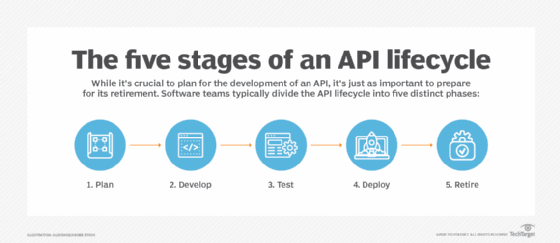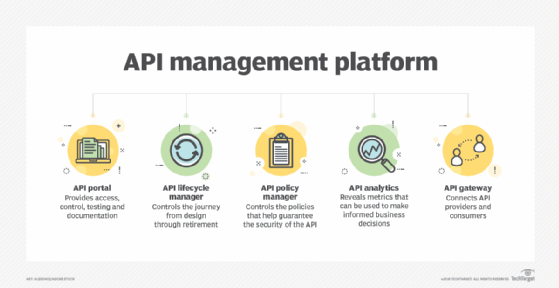API lifecycle management
What is API lifecycle management?
API lifecycle management is a part of application programming interface management that supports the design, development and maintenance of APIs, including their transitioning from design and testing to a production environment.
APIs are increasingly recognized as being almost a component of an application or service. This means that like any other program element, they have a lifecycle from planning through retirement. Lifecycle management assures APIs progress through their stages in an orderly way.
APIs link components of software and at the same time are components themselves. Because of this, loss of control of APIs would create a far-reaching and critical risk for any business dependent on them.
API management is generally recognized as requiring three facets, which include the following:
- API design. This stage requires a developer API portal to expose the APIs and support their use in application development.
- API gateway. An API gateway provides API security, thereby securing the underlying components used to fulfill the functional promise of each API.
- API lifecycle management. This part covers the design, development and maintenance of APIs.
While API lifecycle management is a separate capability on this list, it must be exercised in synchrony with the other two capabilities and supported by other tools to discover and gather information on API use and status. API platforms are available that support all these capabilities. However, some users deploy separate products for each of the three areas.
Stages of API lifecycle management
It's generally agreed that APIs undergo five lifecycle phases. Businesses are increasingly emphasizing the importance of full lifecycle API management where developers manage the entire lifespan of an API. The following are the five phases that make up the API lifecycle:
- Planning and design. A development team must identify one or more problems that can be solved with an API. When productizing APIs, developers solicit input from clients or other stakeholders as to what type of API they need and what functionality or features it should have.
- Development. Developers design the API according to specified requirements. This means coding and building the needed components. Developers create API documentation in this phase that outlines how to work with the API.
- Testing. This stage involves performing tests to ensure the API is fully functional.
- Deployment and use. APIs are deployed in a production environment. API developers monitor the performance of deployed APIs to address any bugs or other issues that arise, thereby improving user experience.
- Retirement. Standards change as APIs are consistently upgraded, so this final phase is where an old API undergoes deprecation. Users switch to an upgraded version or new API.
Various vendors and experts will use different names for each stage of the lifecycle, but the general process is the same. Some lifecycles use more than five stages to ensure every step is covered. However, such a detailed approach can impose a structure on the process that limits tool selection.

API lifecycle management benefits
Effective API lifecycle management leads to the following benefits for businesses:
- Consistency. API lifecycle management ensures consistency throughout all five lifecycle stages as developers are required to oversee them closely.
- Security. When an API is exposed to both internal and external users, security practices are needed to prevent cyberattacks and ensure only authorized users have access to an API. Methods like user authentication can secure APIs.
- Versioning. API lifecycle management enables version control, where APIs can seamlessly be upgraded to new versions or rolled back to previous versions when needed.
- Performance monitoring. During API testing, developers use API analytics to monitor the performance of a deployed API using different API usage metrics.
- Fostering collaboration. Having a standardized process in place means development teams can collaborate throughout each stage whenever necessary.
API lifecycle management challenges
Managing API lifecycles comes with challenges such as the following?
- Efficient app operation. The number one challenge for API lifecycle management is the efficient operation of dependent apps. APIs are means to an end and not the end itself, and that's easily lost when there's too much focus on API lifecycle processes and not enough focus on their impact. It's important to integrate API lifecycle management with the supported application's lifecycle management and with the development portal used to create both the API and its applications.
- API workflows. One broad challenge for API management is with API endpoints. APIs are parts of a multicomponent workflow. As such, they represent relationships as well as services in the traditional service or microservice sense. That means there's nothing independent about an API and considering it in the context of the service it represents can lead to errors. It's important to consider all APIs in terms of the entire workflow they stitch together and effectively manage the lifecycle within an API ecosystem.
- Versioning and compatibility. As APIs evolve and new features are added, it's important to maintain backward compatibility to avoid breaking existing integrations. However, balancing the need for innovation and introducing changes while still supporting older versions of the API can be complex. Compatibility issues can lead to service disruptions, application failures or the need for extensive refactoring, making versioning and compatibility management critical challenges in API lifecycle management.
- Governance and security. APIs often expose sensitive data or provide access to critical business functions, making security a top concern. Implementing proper authentication, authorization, encryption and monitoring mechanisms requires careful planning and ongoing management to protect against potential vulnerabilities and attacks.
- Documentation and collaboration. API documentation helps developers understand the capabilities, use and expected behaviors of APIs. Maintaining accurate and up-to-date documentation is crucial for developers relying on APIs and helps reduce integration efforts and errors. Collaboration between API providers and consumers is also essential to gather feedback, address issues and align on future enhancements.
Best practices for API lifecycle management
The most important thing to remember in defining API lifecycle management practices is to focus first on how APIs are used and the issues the use has exposed. The optimum API lifecycle management practices during development should be identified before selecting tools. Otherwise, early tool consideration will shape best practices and limit options later.
For API management overall, users should consider a unified solution for the three capability areas defined above -- API design, gateway and lifecycle management -- unless there is a reason to look for specific solutions in each capability. API management tools are easily integrated. In most cases, they adapt well to overall development tools and practices. Developing a vision for API use before looking at specific management tools and techniques will help in selecting the right ones.
A general toolkit for API management often doesn't work for users who have evolved an API strategy where decision-making is project specific, without central API control. If this is the case, it's still smart to explore the costs and benefits associated with a shift to management based on a unified API management platform.

Examples of API lifecycle management tools
The following three approaches can be used to select API lifecycle management tools:
- Use the API lifecycle management tools associated with an organization's primary application development toolkit.
- Select an overall API lifecycle management tool for all the API lifecycle stages.
- Choose the best tool for each phase.
Integrating API management with general development is the theme of IBM Cloud Paks, which combines application modernization with IBM's API Connect. Organizations that use IBM's development tools would find this approach easy to adopt and integrated.
Red Hat's OpenShift includes development facilities that can be integrated with its 3scale API Management offering. Competitor VMware offers its Tanzu alternative to OpenShift and supports the integration of the WSO2 API Manager, which is also available as an open source tool.
All three of these products can be integrated with an organization's existing application development infrastructure or used as an overall API lifecycle management tool.
Other API management tools include Apigee Edge, Axway's Amplify, Kong, Mulesoft's Anypoint and Swagger's SwaggerHub. All these products work well as API managers, but Anypoint is generally seen as easier to integrate at a broader development level.
Anypoint is also likely easier to integrate with other API management capabilities for users who want to employ their own API gateways and follow a best-of-breed, self-integrated approach to API management. Most organizations will want to adopt an API program and then customize it with their own design approaches, gateways or lifecycle management steps.
Public cloud providers also offer API management solutions. These might be the best approaches if the development target is public cloud computing or hybrid cloud applications where most API workflows are in the public cloud portion.
Microsoft and Google both emphasize multi-cloud and hybrid cloud API management in their offerings. On the other hand, Amazon's AWS API management tools make the point of saying that simple RESTful APIs might not require formal API management but support basic API gateway capabilities.
Security is a key part of API architecture and development. Find out about critical API vulnerabilities of which every IT team needs to be aware.





